Capture stunning gymnastics shots by exploring seven skyward angles. Start with overhead vault perspectives to freeze explosive movements. Position yourself above the balance beam for precise body alignments. Uneven bars come alive from elevated spots like balconies. Floor routines reveal mesmerizing geometric patterns when viewed from above. For rhythmic gymnastics, focus on the fluid ribbon swirls. Trampoline flips and twists shine with low-angle shots emphasizing height. Finally, team formations showcase synchronicity from an aerial view. These unique perspectives will elevate your gymnastics photography, highlighting the sport's grace and power in ways ground-level shots can't match. Discover how each angle unveils new creative possibilities.
Overhead Vault Perspectives
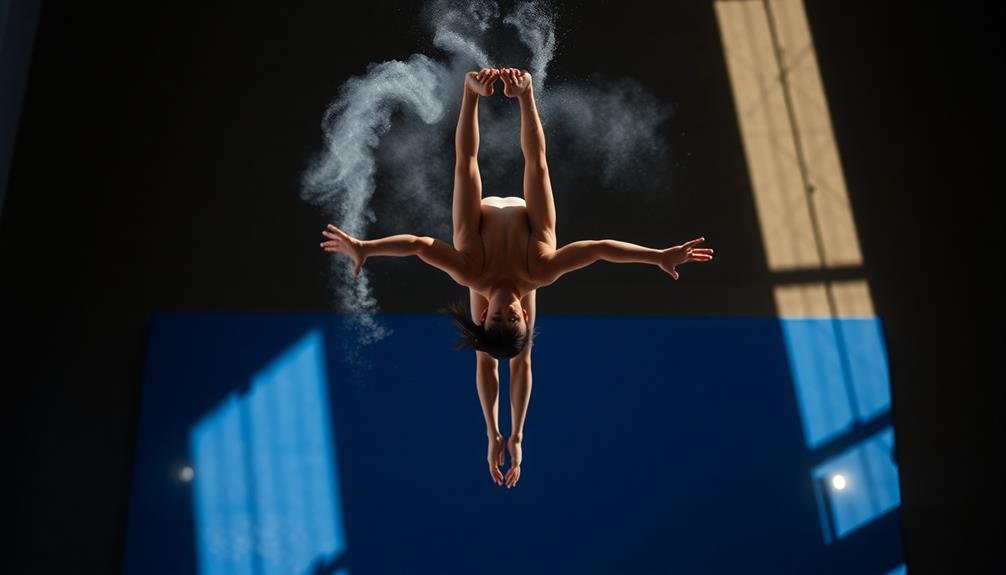
Photographers perched high above the gymnastics arena capture some of the most breathtaking images in the sport. When you're shooting from an overhead perspective, you'll want to focus on the vault, as it offers dynamic angles and explosive movements.
Position yourself directly above the apparatus to capture the gymnast's entire flight path. As the athlete sprints down the runway, you'll have a unique view of their approach. When they hit the springboard, be ready to capture the moment of takeoff. The gymnast's body will create interesting shapes and lines as they rotate through the air.
You'll see their form from angles that ground-level photographers can't access. To get the best shots, you'll need a fast shutter speed to freeze the action. Use a wide-angle lens to capture the entire apparatus and surrounding area.
Don't forget to experiment with different heights and angles to find the most compelling compositions. Pay attention to the gymnast's landing, as it's a vital moment in the routine. You'll be able to capture their expression and body position as they stick the landing, providing a powerful conclusion to your overhead vault sequence.
Balance Beam From Above
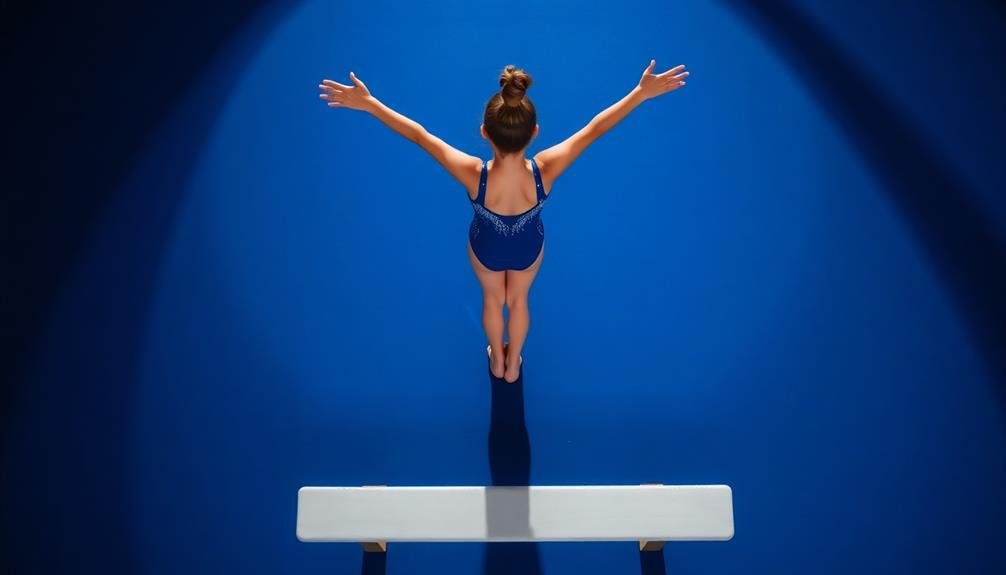
When shooting balance beam routines from above, you'll want to focus on capturing the gymnast's perfect form and alignment.
A bird's eye perspective allows you to showcase the athlete's precise positioning on the narrow beam, highlighting their balance and control.
You'll need to carefully consider equipment placement to achieve this angle, ensuring you're positioned safely while still getting the best possible shots.
Capturing Perfect Form
One of the most striking angles for capturing gymnasts on the balance beam is from directly above. This perspective allows you to showcase the gymnast's perfect form and body alignment in a unique way.
As you position yourself above the beam, you'll need to take into account lighting, timing, and camera settings to achieve the best results.
To capture perfect form from above, focus on key moments during the routine. Look for:
- Extended lines in arabesque or scale positions
- Symmetry during split leaps or jumps
- Precise hand placements during handstands
- The gymnast's shadow creating interesting patterns on the beam
When shooting, use a fast shutter speed to freeze motion and a wide aperture to isolate the gymnast from the background.
Experiment with different focal lengths to vary your composition. A wide-angle lens can create a sense of height and drama, while a longer lens will compress the scene and emphasize the gymnast's form.
Pay attention to the gymnast's facial expressions and body tension, as these details convey the intensity and concentration required in the sport.
Bird's Eye Perspective
The bird's eye perspective offers an enchanting way to showcase gymnasts on the balance beam. You'll capture a unique view that emphasizes the narrow width of the apparatus and the gymnast's incredible balance.
To achieve this shot, you'll need to position yourself directly above the beam, typically using a raised platform or specialized rigging.
When shooting from above, focus on the gymnast's lines and symmetry. You'll see shapes and patterns that aren't visible from ground level. Experiment with different angles to find the most striking composition.
Try capturing the entire length of the beam to show the gymnast's journey, or zoom in tight to highlight specific skills.
Timing is essential for bird's eye shots. You'll want to capture moments of peak difficulty or beautiful poses. Consider using burst mode to guarantee you don't miss the perfect frame.
Pay attention to lighting, as shadows can create interesting effects from this angle. If possible, use multiple light sources to eliminate harsh shadows and enhance the three-dimensional quality of your images.
Equipment Placement Considerations
Safety should be your top priority when setting up equipment for bird's eye beam photography. Guarantee your camera and mounting gear are securely fastened to prevent any risk of falling onto the gymnasts below. Use professional-grade clamps, brackets, and safety cables to anchor your equipment firmly in place.
When positioning your camera, consider the beam's orientation within the venue. Aim for a central placement that captures the entire length of the apparatus. You'll want to align your shot parallel to the beam's long axis for the most visually appealing composition.
Remember to account for the gymnast's movements and guarantee your setup doesn't interfere with their performance or judging sightlines.
Lighting is essential for capturing clear, crisp images from above. Work with the venue's existing lighting system, or bring your own if permitted. Avoid casting shadows on the beam that could distract or confuse gymnasts.
Here's what you might see through your lens:
- A thin, white line bisecting the frame
- Chalk dust creating a hazy atmosphere
- The gymnast's body forming geometric shapes
- A sea of spectators surrounding the apparatus
Uneven Bars Aerial Views

Amidst the dizzying heights of gymnastics competitions, aerial views of uneven bars routines offer a unique perspective on this challenging event.
You'll want to position yourself directly above the apparatus, ideally in an elevated spot like a balcony or catwalk. This vantage point allows you to capture the gymnast's intricate movements and shifts between the two bars.
To get the best shots, you'll need a fast lens with a wide aperture, typically f/2.8 or wider. This will help you freeze the action and create a shallow depth of field, isolating the gymnast from the background.
You'll also want to use a high shutter speed, at least 1/1000th of a second, to avoid motion blur.
When framing your shots, consider the lines created by the bars and the gymnast's body. Look for interesting shapes and patterns as the athlete moves through their routine.
Pay attention to key moments like release moves, shifts, and dismounts. These high-flying elements often make for the most dramatic images.
Don't forget to capture the gymnast's facial expressions, which can add emotional depth to your photos.
Floor Routine Geometric Patterns
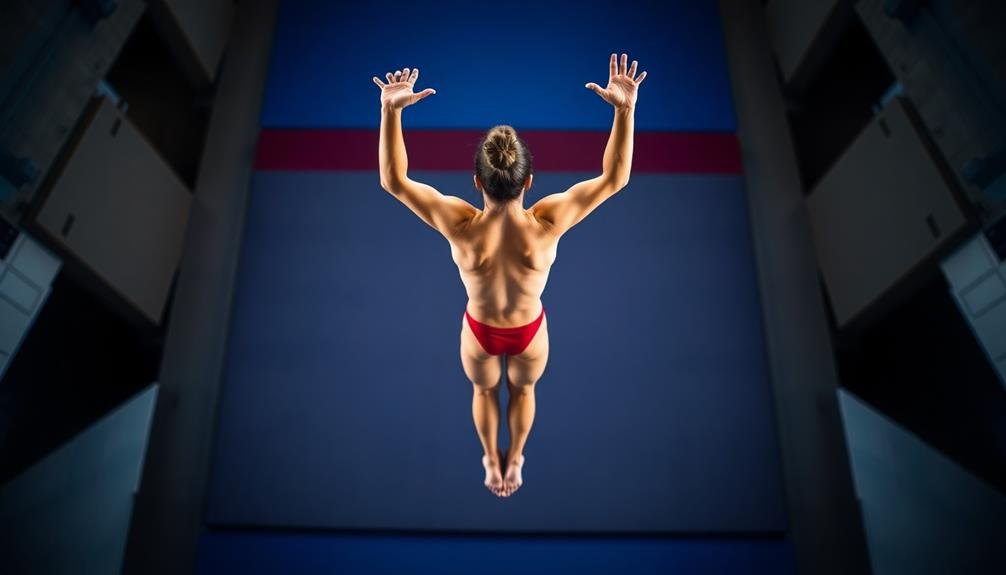
You'll find floor routines offer unique opportunities for capturing geometric shapes in gymnastics photography.
Look for symmetrical patterns created by the gymnast's body against the square mat, especially during elements like splits or handstands.
From above, you can catch striking diagonal lines as the athlete tumbles across the floor, creating dynamic compositions that showcase both skill and artistry.
Capturing Symmetrical Floor Shapes
Through the lens of a skilled photographer, floor routines come alive with geometric splendor. As you capture gymnasts' movements, focus on the symmetrical shapes they create with their bodies and the patterns they trace across the mat. Position yourself at an elevated angle to showcase the full scope of these formations.
Look for moments when gymnasts strike poses that form perfect circles, triangles, or lines. These shapes often occur during splits, handstands, and aerial maneuvers. Time your shots to coincide with the apex of jumps or the precise instant when limbs align in symmetry.
To emphasize floor shapes, consider:
- Using a wide-angle lens to encompass the entire mat
- Shooting from directly above for a bird's-eye view
- Employing long exposures to capture motion trails
- Framing shots to highlight the contrast between the gymnast and the mat
Pay attention to the gymnast's interaction with the floor's boundary lines and corners. These elements can serve as natural frames or leading lines in your composition.
Aerial Views of Diagonals
From above, floor routines reveal their most engaging geometric patterns through diagonal movements. You'll want to position yourself in an elevated spot to capture these dynamic lines as gymnasts traverse the mat. Look for moments when athletes create sharp angles with their bodies, complementing the diagonal paths they follow.
To maximize your shots, focus on these key elements:
| Technique | Equipment | Timing |
|---|---|---|
| Bird's eye view | Wide-angle lens | During tumbling passes |
| Overhead tracking | Gimbal stabilizer | Following dance elements |
| Angled perspective | Telephoto zoom | Capturing leaps and jumps |
| Time-lapse | Tripod | Full routine coverage |
As you shoot, pay attention to the contrast between the gymnast's form and the floor's straight lines. You'll often find that diagonal movements create striking triangles and asymmetrical shapes. Don't forget to adjust your shutter speed to freeze motion or create artistic blur, depending on your creative vision.
Rhythmic Gymnastics Ribbon Swirls
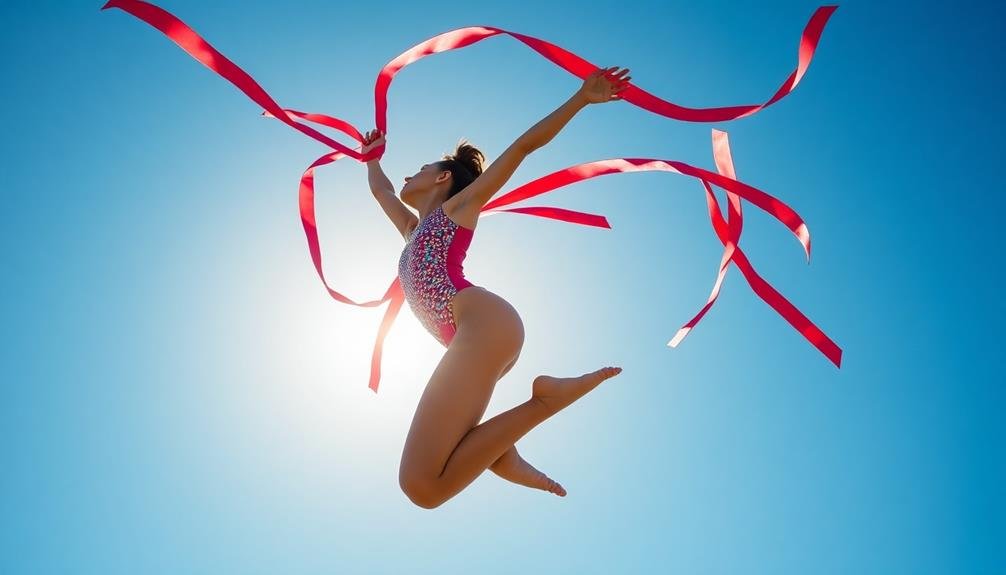
Rhythmic gymnastics' ribbon routines captivate audiences with their graceful, fluid movements. As a photographer, you'll want to capture the mesmerizing swirls and patterns created by the ribbons in motion. To achieve stunning shots, position yourself at various angles and heights to frame the gymnast and the ribbon's trajectory.
When shooting ribbon routines, you'll need to use fast shutter speeds to freeze the ribbon's motion or slower speeds to create artistic blur effects. Experiment with both techniques to find the perfect balance between clarity and artistic expression. Consider using burst mode to capture multiple frames in quick succession, increasing your chances of getting that perfect shot.
Here's what you might aim to capture:
- The gymnast's full body in motion, with the ribbon forming a perfect spiral around them
- Close-ups of the ribbon's intricate patterns as it cuts through the air
- The contrast between the gymnast's focused expression and the flowing ribbon
- Wide-angle shots showcasing the entire performance area with the ribbon's path visible
Remember to adjust your camera settings based on the lighting conditions in the venue. You'll often encounter challenging indoor lighting, so be prepared to increase your ISO or use a wider aperture to maintain fast shutter speeds.
Trampoline Flips and Twists
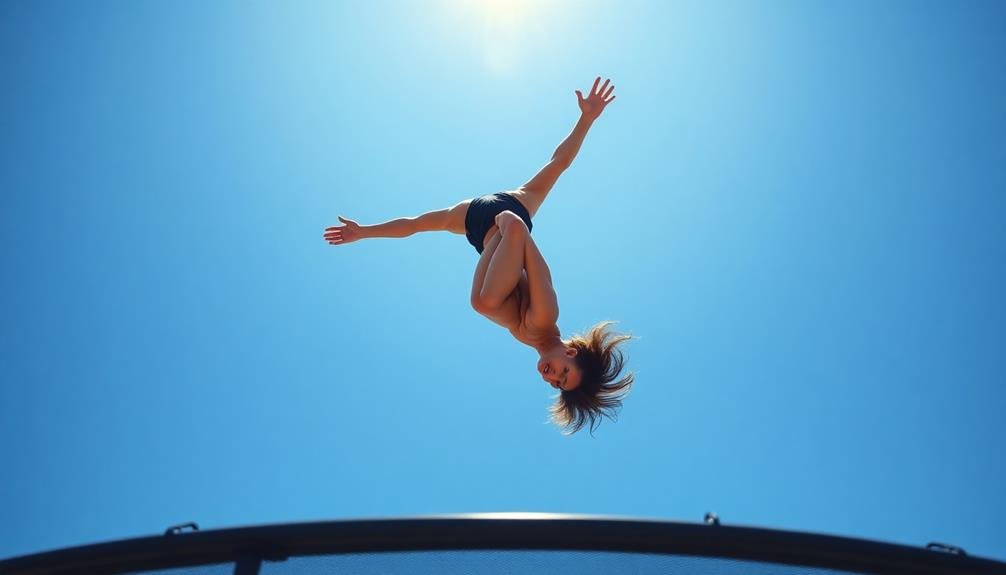
Capturing the exhilarating action of trampoline gymnastics presents unique challenges and opportunities for photographers. You'll need to be quick on your feet and anticipate the athlete's movements to get the perfect shot.
Position yourself at a low angle to emphasize the height and drama of the jumps. A wide-angle lens can help you capture the full trajectory of flips and twists.
To freeze the action, use a fast shutter speed of at least 1/1000th of a second. Continuous shooting mode is essential for capturing the perfect moment in a sequence of rapid movements.
Pay attention to the athlete's form and expression during peak moments of their routine.
Consider using a flash to add drama and freeze motion, especially in indoor venues with challenging lighting. Experiment with slow sync flash techniques to create a sense of motion while keeping the gymnast sharp.
Don't forget to capture the moments before and after the routine. The anticipation and relief on an athlete's face can be just as compelling as their mid-air acrobatics.
Always be ready for unexpected moments that can result in unique, award-winning shots.
Team Formations in Motion
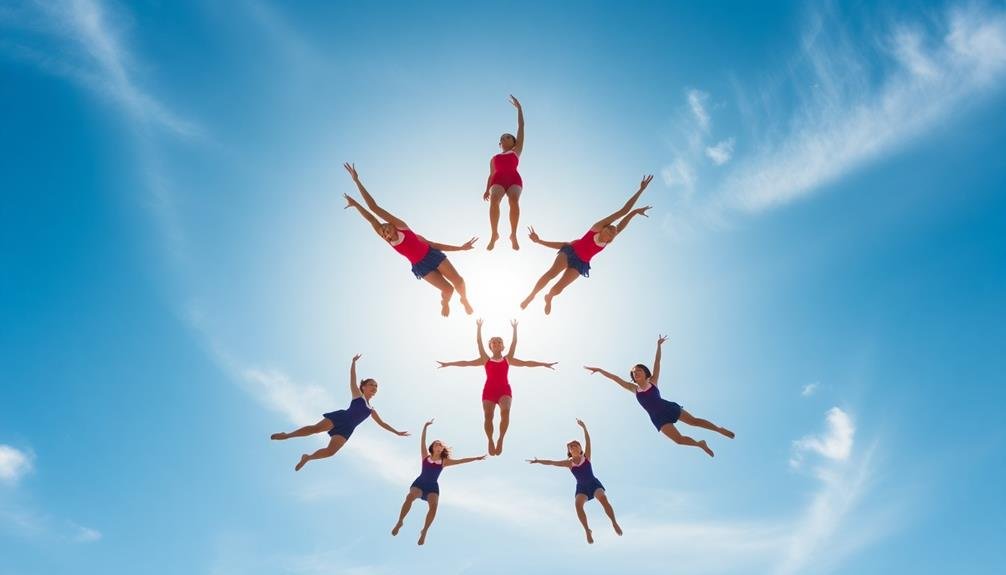
Along with individual performances, team formations in gymnastics offer compelling opportunities for stunning photography. You'll want to capture the synchronicity and precision of multiple gymnasts moving in unison. Position yourself at various angles to showcase the geometry and symmetry created by these formations.
Try shooting from above to capture intricate patterns formed by the team on the floor. Alternatively, get low and shoot upwards to emphasize the height and scale of human towers or pyramids. Don't forget to focus on the facial expressions and body language that convey teamwork and concentration.
Here are some team formations to look out for:
- Human pyramids with gymnasts balanced on each other's shoulders
- Synchronized tumbling passes with multiple athletes in mid-air
- Intricate floor routines with gymnasts weaving between each other
- Group balance poses showcasing strength and flexibility
Experiment with shutter speeds to either freeze the action or create artistic motion blur. Use a wide-angle lens to capture the entire formation, or zoom in on specific details like interlocked hands or perfectly aligned feet.
Remember to take into account the background and lighting to guarantee your subjects stand out. With practice, you'll master the art of capturing these impressive team displays in all their dynamic glory.
Frequently Asked Questions
What Camera Settings Are Best for Capturing Fast-Moving Gymnasts?
You'll want to use fast shutter speeds, around 1/1000 or higher, to freeze motion. Set a wide aperture (f/2.8-f/4) for background blur. Bump up your ISO if needed. Continuous autofocus and burst mode are essential.
How Do You Ensure Safety When Photographing From Elevated Positions?
When photographing from elevated positions, you'll want to prioritize safety. Always use secure platforms or harnesses, don't lean over edges, and follow venue rules. It's essential to stay alert and maintain stable footing while you're shooting.
Are There Specific Lighting Techniques for Gymnastics Photography?
You'll want to use fast shutter speeds and wide apertures for gymnastics photography. Avoid harsh shadows by using diffused lighting. If you're indoors, bump up your ISO. Don't forget to capture the athlete's facial expressions during their routines.
What Legal Considerations Exist When Photographing Gymnasts, Especially Minors?
When photographing gymnasts, especially minors, you'll need parental consent. You should respect privacy, avoid locker rooms, and follow event policies. Don't share or sell images without permission. Always prioritize the athletes' safety and dignity.
How Can Photographers Gain Access to Restricted Areas During Competitions?
You'll need proper credentials and permissions to access restricted areas during competitions. Contact event organizers or the venue's media relations team in advance. Always follow safety protocols and respect athletes' privacy when you're granted access.
In Summary
You've now got seven unique angles to elevate your gymnastics photography. Don't be afraid to experiment with these overhead perspectives. They'll add drama and intrigue to your shots. Remember, timing is essential, so be patient and anticipate the gymnasts' movements. With practice, you'll capture stunning images that showcase the sport's grace and power from above. So grab your camera, head to the gym, and start shooting skyward. Your portfolio will thank you!

As educators and advocates for responsible drone use, we’re committed to sharing our knowledge and expertise with aspiring aerial photographers.




Leave a Reply